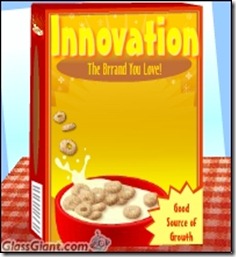in·no·va·tion
noun \ˌi-nə-ˈvā-shən\
1: the introduction of something new
2: a new idea, method, or device
Merriam-Webster dictionary
 Innovation is a powerful word – a label for the stream of activity as well as the new things that organizations create. CEOs increasingly cite innovation as their top priority. It has become the organizational imperative, with the power to revive a company, a category, and create the future.
Innovation is a powerful word – a label for the stream of activity as well as the new things that organizations create. CEOs increasingly cite innovation as their top priority. It has become the organizational imperative, with the power to revive a company, a category, and create the future.
What If the term “Innovation” were a brand? Would it be a strong brand, a profitable brand? Viewing “innovation” as a brand helps to clarify some issues caused by the overuse and misapplication of the term.
First, what is a brand? There are lots of descriptions but most would agree that a brand is a name or mark, identifying a product or service as well as the clear and unique benefit that product or service delivers Seth Godin goes further: “A brand is the set of expectations, memories, stories and relationships that, taken together, account for a consumer’s decision to choose one product or service over another….” Perfect description of brand Innovation if you ask me (especially when you consider its less inspirational competitors – cost cutting, profit improvement, efficiency, etc.).
Innovation Has Become Anything New
The brand “innovation” has one big problem. It means so many different things to different people. Its ubiquity and overuse have confused us as to the actual product or delivery. The CEO uses the brand to describe future disruptive, breakthrough technological advancements. In day to day business, however, innovation is a term used to describe any new activity, whether it is the way operations loads a product into a shipping case sideways rather than on end, a new approach to answering customer service calls, or the way a PR campaign uses sampling at an event for the first time. You get the picture. Innovation can be used to describe anything new, anything.
The Innovation Sub Brand
The Innovation brand is in need of a descriptive sub-brand. Kellogg’s has Corn Flakes, Kraft has Macaroni and Cheese, Apple has the iPad. Sub brands can be good descriptors and provide meaning. Here are a few good innovation sub brands: Process improvement, new product development, brand extension, redesigns, ideation, cost savings, range consolidation, efficiency improvements. Innovation would be the house brand or master brand.
In the case of innovation, however, once the sub brand is put in place, the master brand would no longer be needed as it really provides no additional reason to choose it over other activities. That is ultimately the weakness of the brand (and term) innovation. Its been applied so often, it has become a throwaway.
Innovation activity will continue to be a top priority for organizations, so using the name of the actual process or product provides clarity for the people charged with its creation within their organization.


If Innovation were a product, it would deliver beyond product: http://on.wsj.com/8pxCn3